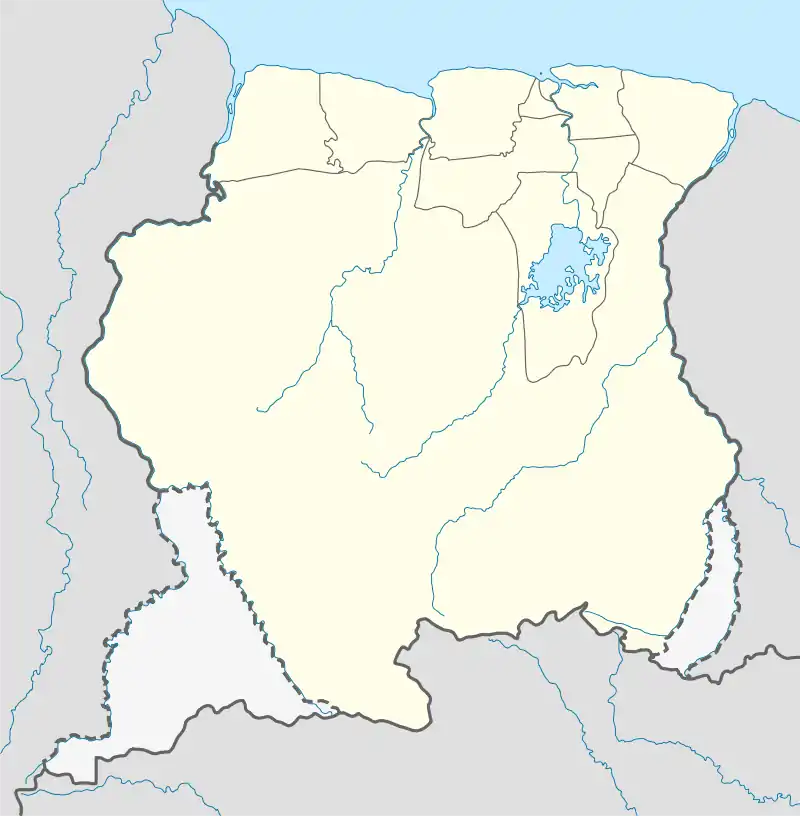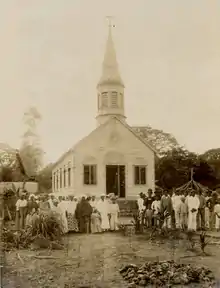Brooskampers
The Brooskampers (also: Bakabusi Nengre) were a Maroon people, descendants of runaway African slaves, living in the forested interior of Suriname. The tribe is related to the Saramaka, and originated from Loango-Angola.[4] The Brooskampers gained autonomy in 1863, but sold their land in 1917.
Bakabusi Nengre | |
|---|---|
| Total population | |
| n/a | |
| Languages | |
| Sranan Tongo, Dutch formerly: undefined English based creole | |
| Religion | |
| Roman Catholic & Winti | |
| Related ethnic groups | |
| Saramaka, Aluku |
Rorac | |
|---|---|
Former village & plantation | |
 Rorac Location in Suriname | |
| Coordinates: 5.6527°N 55.0485°W | |
| Country | |
| District | Commewijne District |
| Resort | Meerzorg |
| Government | |
| • Captain | Broos |
| • Captain | Kaliko |
| Area | |
| • Total | 9.16 km2 (3.54 sq mi) |
| Population (1862)[3] | |
| • Total | ca.200 |
| Time zone | UTC-3 |
History
In the 1740s, the tribe lived in the swamps near Surnau Creek[3] in a camp founded by Tata Kukudabi.[5] In 1772, part of the tribe left and joined the Aluku.[3] In 1862, escaped slaves from plantation Rac à Rac joined the Brooskampers. This was during the preparations of the planned emancipation of the slaves, and therefore the existence of another tribe worried the government.[6] The population of Brooskampers was estimated at about 200 people.[3] At first the government tried to attack them, however the troops got bogged down in the swamp, and had to retreat.[3]

On 2 September 1863, a peace treaty was signed offering the tribe the abandoned plantations Klaverblad and Rorac.[7][1] No granman (paramount chief) was appointed instead Broos and his brother Kaliko were installed as kabitens (captains).[1]
At first they didn't trust the colonists and hid in the forest behind Klaverblad, however in 1874 the Brooskampers settled at the plantations.[8] In 1891, a temporary church was opened by the Catholic priests who were in Bethesda on the other side of the Suriname River. In 1898, a school was opened, and in 1900, a real church was finished.[8] Klaverblad is no longer mentioned during the 20th century. The almanac of 1910, lists Klaverblad as owned by J. Braumuller. Rorac, on the other hand, is owned by Johannes Babel, the son of Broos and his successor as kabiten. The plantation produced cacao, corn and rice.[9]
Road surfacing material which was purchased from the village, contained bauxite.[10] In 1917,[7] kabiten Johannes Babel and Alcoa negotiated a deal which was accepted by the tribe,[11]the lands were sold, and the people settled in Tout-Lui-Faut near Paramaribo.[7] In 1920, the last 20 inhabitants were asked to leave and given a ƒ 500,- (€ 2,800 in 2018[12]) moving premium.[13]
In 2011, Alcoa ceased bauxite production at the site.[14] Ronald Babel, one of the descendants, and other family members had restored the damaged graves at the plantation,[4] and erected a Winti shrine at the site.[15]
Notable people
- Ryan Babel (1986), football player[8]
References
- "Plantage Rorac". Suriname Plantages (in Dutch). Retrieved 27 July 2020.
- "Plantage Claverblad" (in Dutch). Retrieved 30 July 2020.
1,130 Surinamese acres for Klaverblad + 1,000 for Rorac = 2,130 x 0.43 (hectares/sr acre) ÷ 100 (hectares->km) = 9.16 km2
- Edwin Marshall. "De Brooskampers". NAKS Suriname (in Dutch). Retrieved 27 July 2020.
- "Rorac; een Surinaams volksliedje nader belicht". Suriname.nu (in Dutch). Retrieved 30 July 2020.
- "Tweede gedeelte: de boschnegers". Delpher.nl. Bijdragen tot de Taal-, Land- en Volkenkunde van Nederlandsch-Indië. 1903. p. 530. Retrieved 30 July 2020.
- Scholtens 1994, p. 33.
- Scholtens 1994, p. 34.
- "Rorac". Suriname.nu (in Dutch). Retrieved 30 July 2020.
- "Surinaamsche Almanak voor het Jaar 1910". Digital Library for Dutch Literature (in Dutch). 1909. Retrieved 31 July 2020.
- "Aluminium". Canon van Nederland (in Dutch). Retrieved 30 July 2020.
- "Twee Amerikanen onderhandelen met de eigenaren van Onoribo en De Vrijheid". De West via Delpher (in Dutch). 26 June 1950. Retrieved 30 July 2020.
Referred to both as captain and granman in the newspaper article
- "De waarde van de gulden / euro". Internationaal Instituut voor Sociale Geschiedenis (in Dutch). Retrieved 31 May 2020.
- "Rorac". De Surinamer via Delpher (in Dutch). 12 February 1920. Retrieved 31 July 2020.
- "Notulen". Rorac Association (in Dutch). Retrieved 30 July 2020.
- "Fotoalbum". Rorac Association. Retrieved 30 July 2020.
Bibliography
- Hoogbergen, Wim (2009). Het kamp van Broos en Kaliko (in Dutch). Paramaribo: Vaco Publisher. ISBN 9789991400853.
- Hoogbergen, Wim (2008). Out of slavery : a Surinamese roots history. Berlin: LIT Verlag. ISBN 9783825881122.
- Scholtens, Ben (1994). Bosneger en overheid in Suriname. Radboud University Nijmegen (Thesis) (in Dutch). Paramaribo: Afdeling Cultuurstudies/Minov. ISBN 9991410155.CS1 maint: ref=harv (link)
External links
| Wikimedia Commons has media related to Brooskampers. |